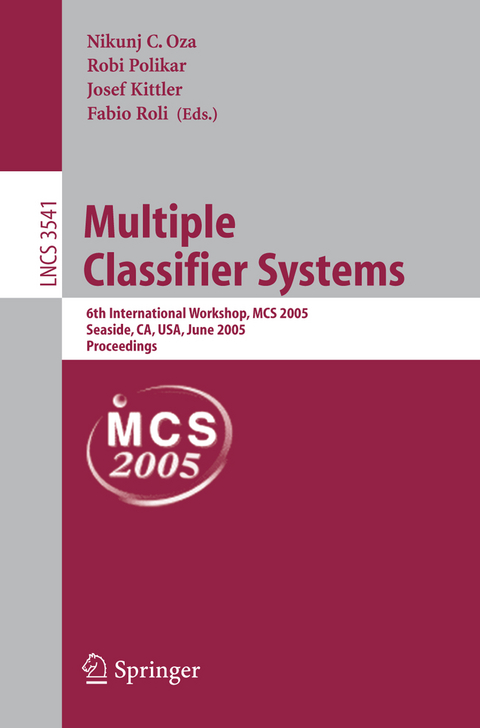
Multiple Classifier Systems
Springer Berlin (Verlag)
978-3-540-26306-7 (ISBN)
Future Directions.- Semi-supervised Multiple Classifier Systems: Background and Research Directions.- Boosting.- Boosting GMM and Its Two Applications.- Boosting Soft-Margin SVM with Feature Selection for Pedestrian Detection.- Observations on Boosting Feature Selection.- Boosting Multiple Classifiers Constructed by Hybrid Discriminant Analysis.- Combination Methods.- Decoding Rules for Error Correcting Output Code Ensembles.- A Probability Model for Combining Ranks.- EER of Fixed and Trainable Fusion Classifiers: A Theoretical Study with Application to Biometric Authentication Tasks.- Mixture of Gaussian Processes for Combining Multiple Modalities.- Dynamic Classifier Integration Method.- Recursive ECOC for Microarray Data Classification.- Using Dempster-Shafer Theory in MCF Systems to Reject Samples.- Multiple Classifier Fusion Performance in Networked Stochastic Vector Quantisers.- On Deriving the Second-Stage Training Set for Trainable Combiners.- Using Independence Assumption to Improve Multimodal Biometric Fusion.- Design Methods.- Half-Against-Half Multi-class Support Vector Machines.- Combining Feature Subsets in Feature Selection.- ACE: Adaptive Classifiers-Ensemble System for Concept-Drifting Environments.- Using Decision Tree Models and Diversity Measures in the Selection of Ensemble Classification Models.- Ensembles of Classifiers from Spatially Disjoint Data.- Optimising Two-Stage Recognition Systems.- Design of Multiple Classifier Systems for Time Series Data.- Ensemble Learning with Biased Classifiers: The Triskel Algorithm.- Cluster-Based Cumulative Ensembles.- Ensemble of SVMs for Incremental Learning.- Performance Analysis.- Design of a New Classifier Simulator.- Evaluation of Diversity Measures for Binary Classifier Ensembles.- Which Is the Best Multiclass SVM Method? An Empirical Study.- Over-Fitting in Ensembles of Neural Network Classifiers Within ECOC Frameworks.- Between Two Extremes: Examining Decompositions of the Ensemble Objective Function.- Data Partitioning Evaluation Measures for Classifier Ensembles.- Dynamics of Variance Reduction in Bagging and Other Techniques Based on Randomisation.- Ensemble Confidence Estimates Posterior Probability.- Applications.- Using Domain Knowledge in the Random Subspace Method: Application to the Classification of Biomedical Spectra.- An Abnormal ECG Beat Detection Approach for Long-Term Monitoring of Heart Patients Based on Hybrid Kernel Machine Ensemble.- Speaker Verification Using Adapted User-Dependent Multilevel Fusion.- Multi-modal Person Recognition for Vehicular Applications.- Using an Ensemble of Classifiers to Audit a Production Classifier.- Analysis and Modelling of Diversity Contribution to Ensemble-Based Texture Recognition Performance.- Combining Audio-Based and Video-Based Shot Classification Systems for News Videos Segmentation.- Designing Multiple Classifier Systems for Face Recognition.- Exploiting Class Hierarchies for Knowledge Transfer in Hyperspectral Data.
| Erscheint lt. Verlag | 1.6.2005 |
|---|---|
| Reihe/Serie | Image Processing, Computer Vision, Pattern Recognition, and Graphics | Lecture Notes in Computer Science |
| Zusatzinfo | XII, 432 p. |
| Verlagsort | Berlin |
| Sprache | englisch |
| Maße | 155 x 235 mm |
| Gewicht | 1380 g |
| Themenwelt | Informatik ► Grafik / Design ► Digitale Bildverarbeitung |
| Informatik ► Theorie / Studium ► Künstliche Intelligenz / Robotik | |
| Schlagworte | Algorithmic Learning • algorithms • biometric authentication • classification • Classifier SYstems • Clustering • Cognition • Document Analysis • Image Analysis • learning • Learning classifier systems • machine learning • Multiple Classifier Systems • Neural networks • pattern recognition • Performance • Statistical Learning • Textur • Time Series Analysis • verification |
| ISBN-10 | 3-540-26306-3 / 3540263063 |
| ISBN-13 | 978-3-540-26306-7 / 9783540263067 |
| Zustand | Neuware |
| Informationen gemäß Produktsicherheitsverordnung (GPSR) | |
| Haben Sie eine Frage zum Produkt? |
aus dem Bereich


